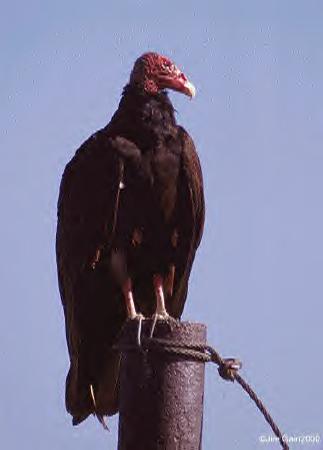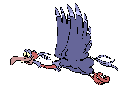|
Canku Ota |
|
(Many Paths) |
|
An Online Newsletter Celebrating Native America |
|
November 18, 2000 - Issue 23 |
|
|
|
|
|
Why the Buzzard Flies So High |
|
Retold by Little Jumper from Indian Campfire Tales by W. S. Phillips |
|
Print and color your very own buzzard!!! |
(Not recommended for your Fall Feast Dinner Menu)
 Cathartes
aura Cathartes
aura BIRD Order Falconiformes Range Southern Canada to southernmost parts of South America. What do they look like? Turkey vultures are easily recognized by their bald red heads. The rest of their bodies, which ARE covered with feathers, are dark brown or black. These are big birds with a nearly 6 foot wingspan, and standing almost 2 1/2 feet tall. There huge wings make their ground-walking a little awkward, but they are extremely adept in the air! What do they eat? Turkey vultures can soar for hours without flapping at all by riding on thermal air currents which rise as the sun warms them. As the vulture soars, it depends on its incredible sense of smell to help it locate its next meal: road kill, perhaps, or maybe a dead cow. Turkey vultures are scavengers, which means they don't kill the food they eat--it either dies or something else kills it. Even though this seems pretty GROSS, they actually form a very important part of the ecosystem, helping to keep it clean! Habitat Lives over open plains, deserts and forests; rests on cliffs in hollow trees or on the ground under dense cover. Where do they sleep? Turkey vultures roost communally, which means they sleep together in groups, and they also seem to eat communally, helping each other rip apart the meat and sharing whatever food they find. How do they attract a mate? These vultures don't have a voice box and so can't sing or make calls like most birds do. Instead, if they are trying to attract someone's attention (like during their courtship display), they must make noises by grunting, hissing, or huffing instead! They also fan out their wings and parade around sometimes--looking pretty silly! Special Adaptations • Bare head and neck keep bird clean while it thrusts its head into animal carcass to feed. • Long beak with hooked end designed for tearing flesh. • Long toes provide a stable base while bird is feeding. • Long, broad wings designed for soaring over great distances in search of prey. • Large eyes and excellent eyesight help bird locate prey from great heights. • Dark plumage helps to camouflage bird in dense cover or at nesting site. (Red head does not occur in young birds.)  Table Manners? Table Manners? Vultures are social animals. Several dozen turkey vultures may flock to a large carcass within minutes after its death. Although turkey vultures are usually silent, this all changes when they gather to eat. Silence is replaced with shoving, hissing, grunting, growling and squabbling, and fighting between vultures breaks out at times. Injury, however, rarely occurs during the upheavel of the feeding frenzy. The bare head of a turkey vulture is an adaptation for its scavenging life style, and helps keep the head clean when the vulture sticks its head inside the carcass of a large animal. Fascinating Facts Turkey vultures are one of the few birds with a well-developed olfactory sense (sense of smell) which they use to locate carrion. Turkey vultures have been used to detect the location of natural gas leaks, because they will circle over the leak lured by the rotten-meat odor added to the gas! No animal is known to prey upon adult turkey vultures! Of all the numerous carcasses lying on the ground throughout the world at any given moment, few are ever considered obnoxious by the average person, because in fact, they are seldom if ever even seen. The primary reason is that shortly after death the carcass is removed, converted to fertilizer, and spread throughout the countryside. The entity assigned by mother nature to the primary responsibility for this job is a variety of carrion eaters. Included is the family of scavenger birds which includes vultures. In much of the United States the resident agent is the Turkey Vulture. Scientific knowledge of the Turkey Vulture, Cathartes aura, is limited. The bird is a common carrion eater, scavenging in the mountains and valleys, and alongside the highways. The immature bird has a black head and the mature bird has a red head. The Turkey Vulture soars gracefully in wide circles for hours, holding its wings in a broad "V" and tilting quickly from side to side. It is one of the most graceful soaring birds in the Blue Sky Above. This much we know. What we don't know are many things about the life of the vulture. For instance, when one soaring bird finds a carcass and starts feeding, numerous other vultures fly in from beyond the range of human vision and join in the feast. How do they communicate over such vast distances?  In the fall the vultures fly south. Where they go, where their rookery is, how they communicate, and many other questions, go unanswered. A little-known instinct of the Turkey Vulture is its ability to return to its summer feeding grounds on the Vernal Equinox, the same day the swallows return to Capistrano, each year. One important question concerns the ability of the vulture to consume, with no bad effects, the rotten diseased carcass of an animal which died of infection and illness. Thanks to the Turkey Vulture such carcasses are quickly cleaned up and the danger of their infection to other animals or humans is removed. The bird's excrement is sanitized. The knowledge of how they can eat diseased meat with no ill effects could be extremely important to medical science. |
|
Vulture |
|
Vultures |
|
|
|
|
| Canku Ota is a free Newsletter celebrating Native America, its traditions and accomplishments . We do not provide subscriber or visitor names to anyone. Some articles presented in Canku Ota may contain copyright material. We have received appropriate permissions for republishing any articles. Material appearing here is distributed without profit or monetary gain to those who have expressed an interest. This is in accordance with Title 17 U.S.C. section 107. |
|
Canku Ota is a copyright of Vicki Lockard and Paul Barry. |
|
The "Canku Ota - A Newsletter Celebrating Native America"
web site and its design is the Copyright © 1999 of Paul C. Barry. |
 In the
beginning, the birds had no feathers at all, and when winter came, they were very cold. So they held council with
the gods and asked for something to cover themselves with. The gods replied that feather coats were already made
and waiting for them. The feather coats, however, were far away and only one bird could go and bring them back
for the others.
In the
beginning, the birds had no feathers at all, and when winter came, they were very cold. So they held council with
the gods and asked for something to cover themselves with. The gods replied that feather coats were already made
and waiting for them. The feather coats, however, were far away and only one bird could go and bring them back
for the others. So he gathered up the all the smaller coats of feathers and started back, flying high in the air.
So he gathered up the all the smaller coats of feathers and started back, flying high in the air.